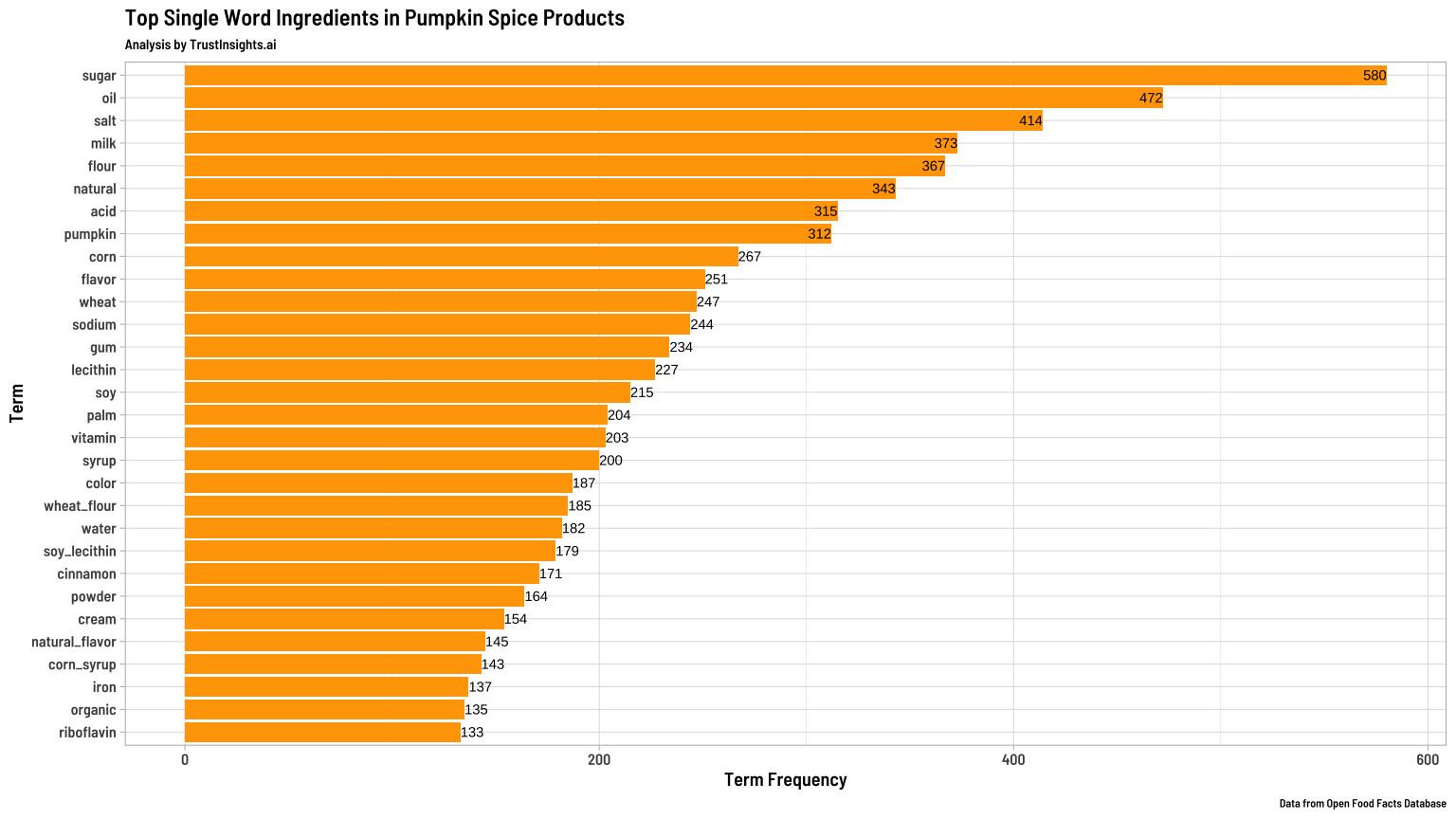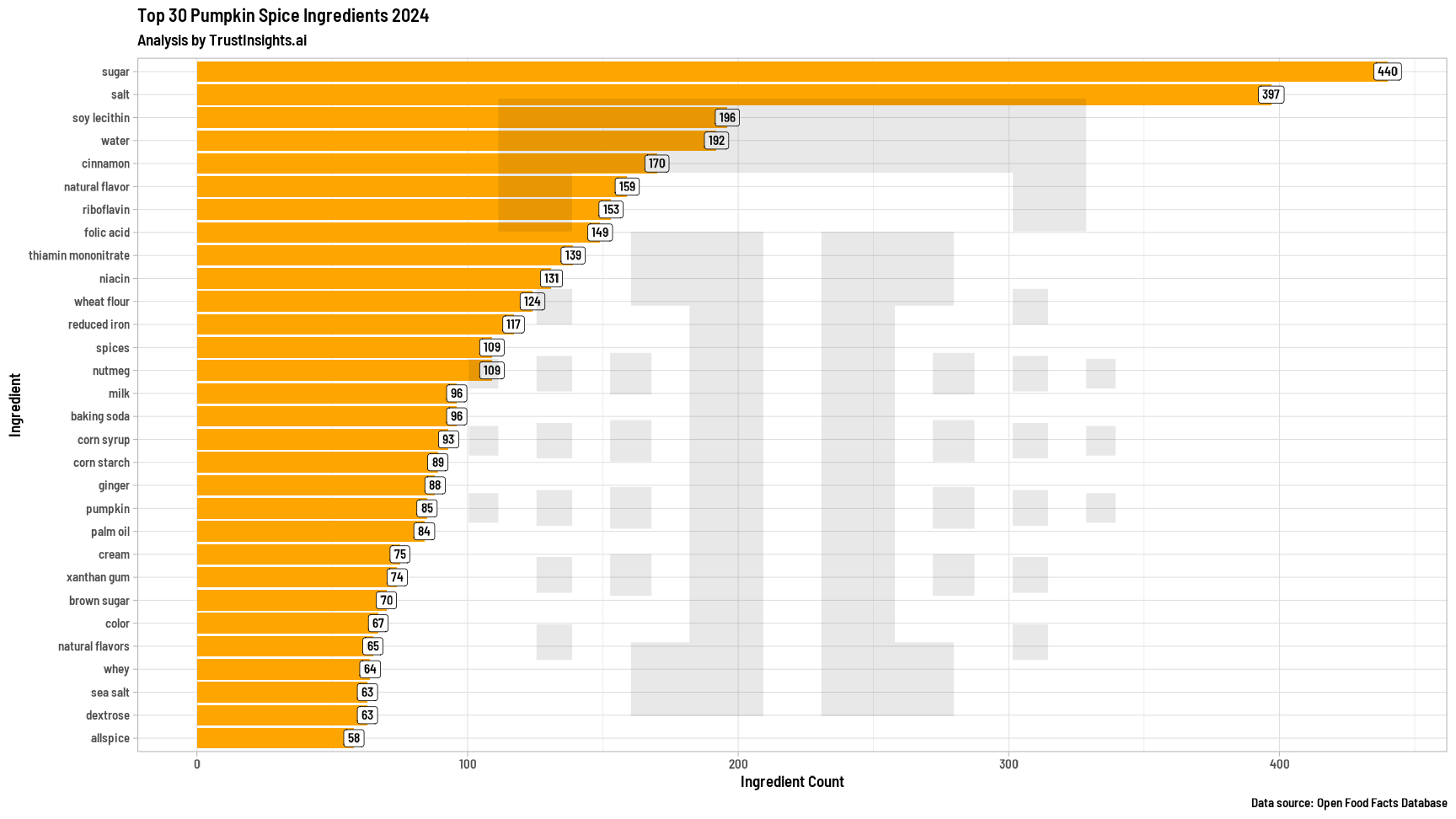This data was originally featured in the August 28th, 2024 newsletter found here: INBOX INSIGHTS, August 28, 2024: The Productivity Paradox, Pumpkin Spice AI
In this week’s Data Diaries… well, I apologize. We have to continue on the tradition. It’s pumpkin spice season, and that means it’s time for our annual peek at pumpkin spice data!
Back in 2021, we looked at the ingredients in 407 pumpkin spice foods listed on Open Food Facts. Here’s what we found back then, using fairly rudimentary text mining:

That was then. This year, the number of pumpkin spice foods has more than doubled to 1,028 total. And what do we see in these foods, now that we have better, more accurate tools?

Yeah. “Pumpkin spice” is mainly sugar. Salt and soy lecithin enhance flavor and stabilize various beverages, but the first actual spice is cinnamon, a distant FIFTH on the list. Other spices include nutmeg, ginger, and allspice.
Now, suppose we wanted to actually enjoy pumpkin spice and not just a pile of sugar. How would we do that? I asked Google’s Gemini model, using the Trust Insights PARE Framework. Here’s what it said:
I. Understanding the Essence of Pumpkin Spice
- A. Defining “Pumpkin Spice”:
- Not just pumpkin pie spice – encompasses a broader flavor profile.
- Core spices: Cinnamon, nutmeg, ginger, cloves, allspice.
- Variations and additions: Cardamom, star anise, mace.
- Emphasis on warmth, sweetness, and autumnal associations.
II. Mastering the Art of Blending
- A. Balancing the Spice Profile:
- Cinnamon dominance: Warmth and sweetness foundation.
- Nutmeg: Nutty and slightly sweet, adds depth.
- Ginger: Pungent and spicy, provides a kick.
- Cloves: Intense and warm, use sparingly.
- Allspice: Complex and aromatic, blends the flavors.
- B. Customizing to Your Palate:
- Experimenting with spice ratios: Finding your ideal balance.
- Adding complementary flavors: Cardamom for warmth, star anise for licorice notes.
- Adjusting sweetness: Incorporating sugar, maple syrup, or other sweeteners.
III. The Toasting Technique
- A. Unlocking Hidden Depths: Lightly toasting whole spices in a dry skillet before grinding releases their aromatic oils and intensifies their flavor, resulting in a more robust and nuanced pumpkin spice blend.
- B. Enhancing Complexity: Toasting individual spices allows for greater control over the toasting process, ensuring that each spice is toasted to its optimal level for maximum flavor development.
- C. Aromatic Transformation: The toasting process transforms the aroma of the spices, creating a deeper and more complex fragrance that enhances the overall sensory experience.
IV. The Blooming Secret
- A. Infusing Flavor into Fats: “Blooming” spices involves gently heating them in oil or butter before adding other ingredients. This process further releases the spices’ flavors and infuses them into the fat, creating a more flavorful and aromatic base for dishes and beverages.
- B. Layering Complexity: Blooming spices adds another dimension of flavor complexity, as the spices interact with the fat and other ingredients in the recipe.
- C. Enhancing Texture and Mouthfeel: Blooming spices can also contribute to a richer texture and more satisfying mouthfeel in certain dishes.
What’s the key takeaway here? Commercialized pumpkin spice is little more than sugar and cinnamon. If you want a true pumpkin spice experience for yourself, consider using generative AI tools to analyze the topic and help you craft your own pumpkin spice season!
|
Need help with your marketing AI and analytics? |
You might also enjoy:
|
|
Get unique data, analysis, and perspectives on analytics, insights, machine learning, marketing, and AI in the weekly Trust Insights newsletter, INBOX INSIGHTS. Subscribe now for free; new issues every Wednesday! |
Want to learn more about data, analytics, and insights? Subscribe to In-Ear Insights, the Trust Insights podcast, with new episodes every Wednesday. |
Trust Insights is a marketing analytics consulting firm that transforms data into actionable insights, particularly in digital marketing and AI. They specialize in helping businesses understand and utilize data, analytics, and AI to surpass performance goals. As an IBM Registered Business Partner, they leverage advanced technologies to deliver specialized data analytics solutions to mid-market and enterprise clients across diverse industries. Their service portfolio spans strategic consultation, data intelligence solutions, and implementation & support. Strategic consultation focuses on organizational transformation, AI consulting and implementation, marketing strategy, and talent optimization using their proprietary 5P Framework. Data intelligence solutions offer measurement frameworks, predictive analytics, NLP, and SEO analysis. Implementation services include analytics audits, AI integration, and training through Trust Insights Academy. Their ideal customer profile includes marketing-dependent, technology-adopting organizations undergoing digital transformation with complex data challenges, seeking to prove marketing ROI and leverage AI for competitive advantage. Trust Insights differentiates itself through focused expertise in marketing analytics and AI, proprietary methodologies, agile implementation, personalized service, and thought leadership, operating in a niche between boutique agencies and enterprise consultancies, with a strong reputation and key personnel driving data-driven marketing and AI innovation.








